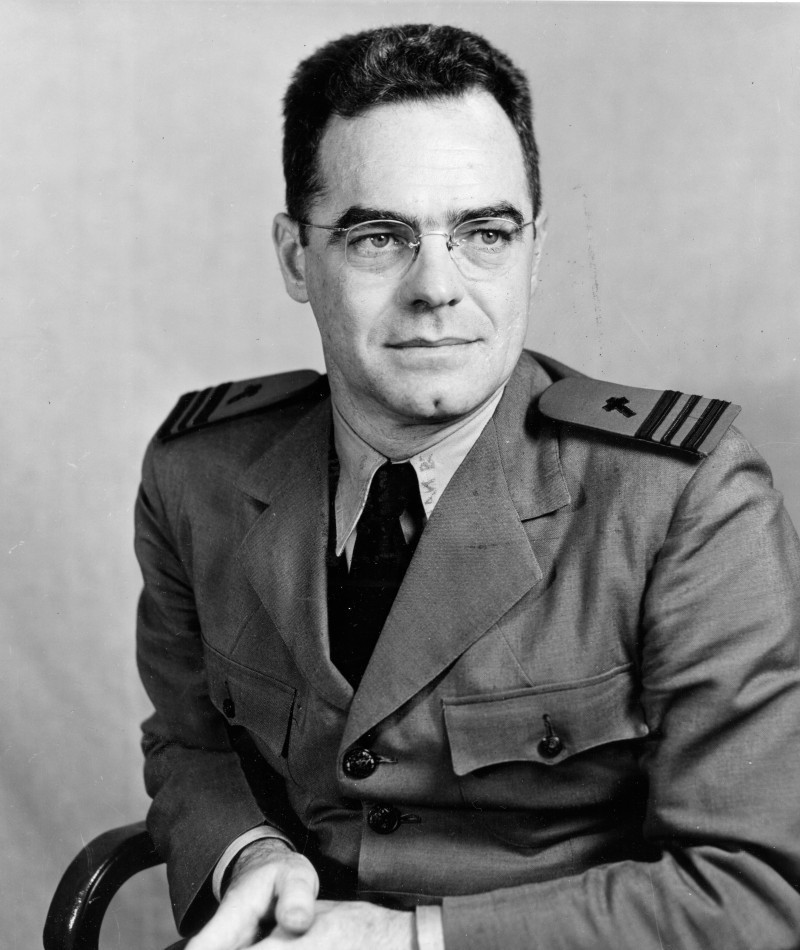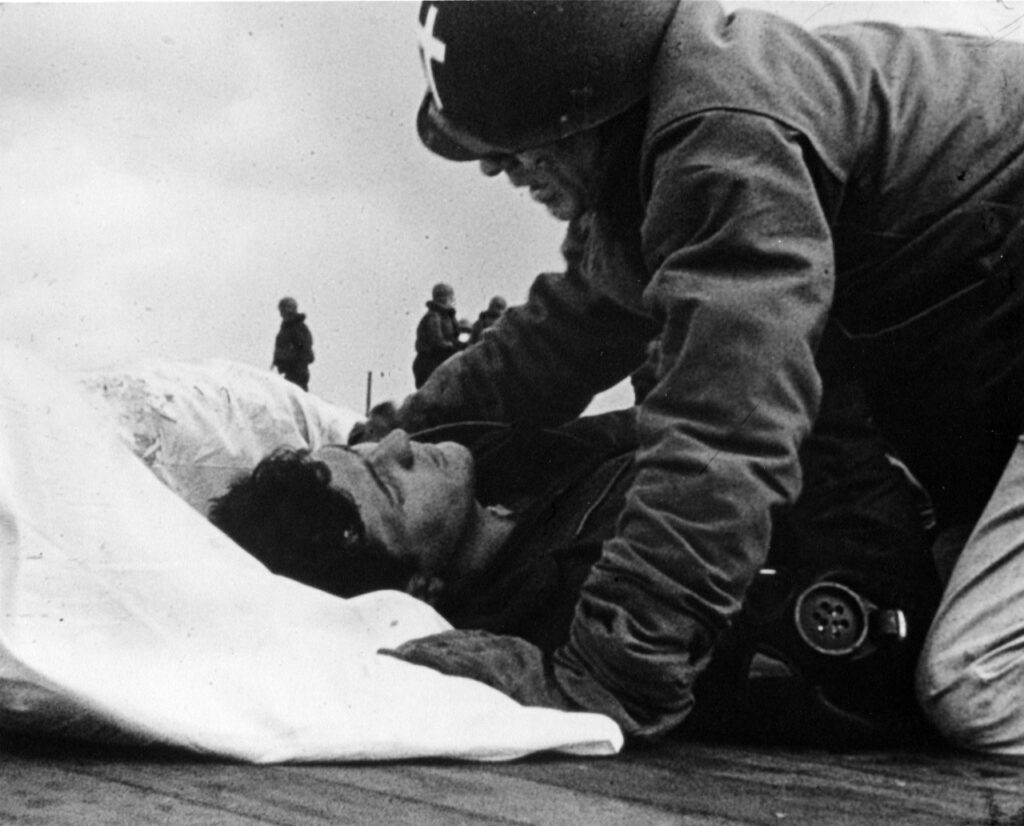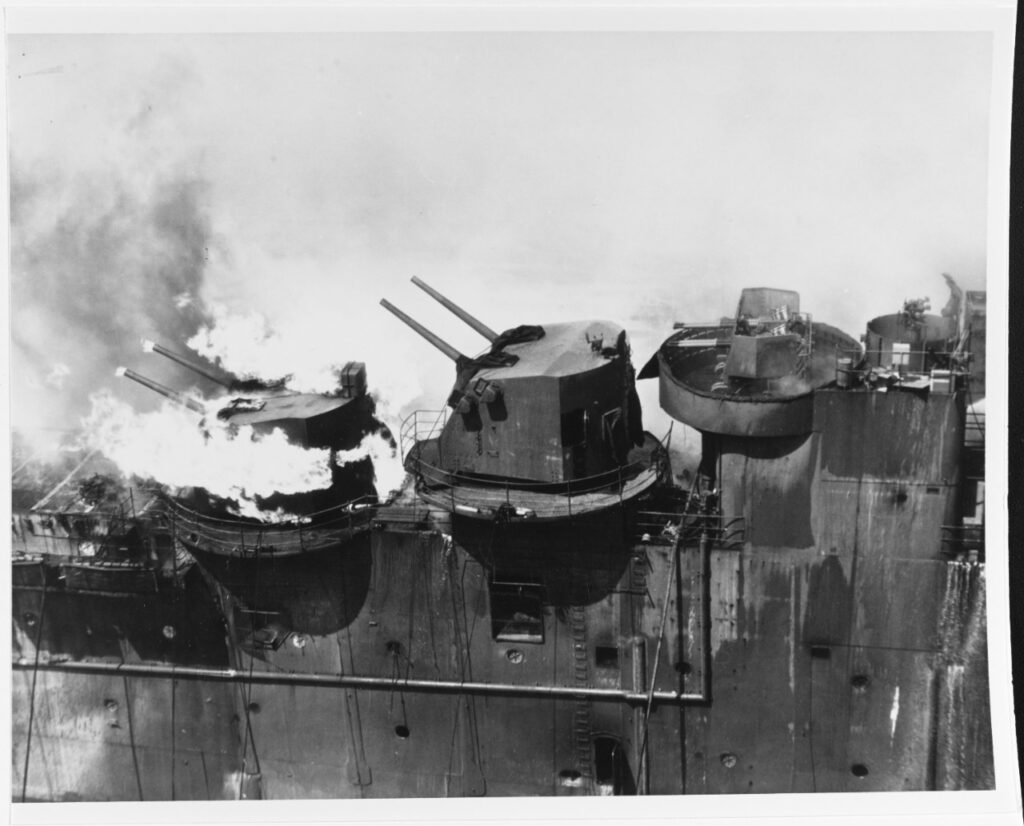Joseph O’Callahan, Chaplain of the USS Franklin, Earns The Medal of Honor

Off the Coast of Japan, March 1945
Lieutenant Commander Joseph O’Callahan, the Catholic chaplain aboard the USS Franklin, an Essex-class “fast carrier,” sat in the officers’ wardroom with his friends near dawn, on a chilly day in March 19451. The Franklin was one of fifteen carriers and numerous battleships, cruisers, and destroyers making up Task Force 58. Led by Admiral Marc Mitscher, their mission was to reduce the number of Japanese Kamikaze planes and create as much destruction as possible to their airfields prior to the invasion of Okinawa. Their secondary mission was to destroy any Imperial Japanese ships found in or near their home ports.2
O’Callahan and his fellow shipmates were tired from being called to general quarters numerous times during the night as the radar showed Japanese aircraft probing the darkness attempting to find the carriers. On this, the morning of 19 March, the Franklin had already begun to launch aircraft to participate in the mission’s second day of airstrikes. The ship’s captain, Leslie Gehres, had lowered readiness to a modified Condition 3 which allowed the tired men not manning anti-aircraft guns to leave their posts for rest or a hot meal.3
Father Joe, as he was known throughout the ship, along with Lieutenant “Red” Morgan and Lieutenant Commander Tommy Greene, were razzing the steward’s mate, Tom Frasure, about the “quality” of the cold French Toast, or as they called it, “fried bread.”4
The Devil Boards The Franklin
While the officers and the steward’s mate bantered, a Japanese bomber snuck through multiple layers of the task force’s defenses and dropped two bombs* penetrating Franklin’s wooden flight deck and exploding on the hangar deck below. On the flight deck, thirty-one aircrew sat in their planes with engines running, all armed with ammunition and carrying either bombs or a Tiny Tim rocket. Twenty-two were in the hangar, one deck down, in various stages of readiness, many surrounded by bombs, rockets, or ammunition waiting to be loaded onto the aircraft.5
The first bomb detonated at or just above the armored hangar deck blowing a hole in it which destroyed or warped the bulkheads and offices on the deck below. The explosion caused massive damage to the air plot and Combat Information Center (CIC) just above the explosion.6
The second bomb detonated at the same time or a second or two after the first exploded, just below the gallery deck and above the parked planes changing the hangar into a hellscape. These explosions ruptured their fuel tanks creating rapidly spreading fires and a massive gasoline vapor cloud which then exploded shooting flames up the elevator wells and out the sides of the open hangar deck. The shock waves from these explosions knocked airplanes on the flight deck above into each other. Their spinning propellers sliced into the other aircraft and their bombs and rockets caused more explosions and fires. This triggered a chain reaction as spilled gasoline ignited and bombs, rockets, and ammunition began to detonate.7 The noise from the explosions was so loud Admiral Mitscher, in his flagship on board the carrier USS Bunker Hill, heard them even though the Franklin was, to them, below the horizon.8
About two hundred men were in a chow line on the hangar deck that stretched from there down a ladder to the mess below. They were instantly killed; many were found naked as their clothes had been blown off them.9
“…Helmeted With The Cross…”
One deck below, Father Joe and the others in the wardroom mess were knocked to the deck. In his memoir, he recounted:
Those first moments were given over to instinct, the mad clutch for life. But I followed blind instinct only for a split second until my mind focused.10
Within seconds, he reported, more than one hundred sailors fled into the wardroom. Twice massive explosions knocked them off their feet.11 Volunteers were sent to find exits to safety. Reports came back that there was no escape aft, and that one route forward was blocked. The only way out was through the hangar deck to the fo’c’sle.
The group then worked its way up and forward. Their escape took them past a bulkhead next to the forward elevator. A massive explosion lifted the elevator and dropped it askew back into its well. The men were once again thrown to the deck and this time there was panic, many rushing to climb through an escape hatch that would only allow one person through at a time.
“Here, boys, single file, one at a time through the manhole. Take your turn, Reilly; we’ll all get out faster. I’ll wait my turn. Now, get in single file.” Because my words were clear and loud they commanded respect and inspired confidence.12
The group arrived safely in the fo’c’sle where the junior aviators’ bunk room had been turned into an impromptu hospital. Because it was near his own berth, Father Joe detoured there and grabbed his helmet, his life belt, which was torn, and the vial containing the holy oils.
And thus, belted with a defective float, helmeted with the cross, carrying the holy oils for the dying, I went in search of my proper work.13
Hell On The Flight Deck
He returned to the makeshift hospital and ministered to the dead, dying, and wounded. When he had done everything he could do, he headed to the flight deck. There he found all but 100 feet of the deck consumed with towering flames and billowing smoke.14
The one hundred feet clear of flame was strewn with bodies: burned bodies, mangled, bleeding bodies; everywhere the stench of burned flesh, the sound of deep groans, the clammy feel of men already dead. This was our flight deck.15
Again, he found his proper work. Commander Stephen Jurika, the ship’s navigator, observed O’Callahan from the bridge where he saw him giving Extreme Unction to the mortally wounded lying on the deck. Jurika watched as a Tiny Tim missile ignited and flew down the flight deck over the chaplain’s head.16

Father Joe noticed that firefighting crews had been formed by several officers. He watched as the hose handlers would dive for the deck when explosions went off, then stand up, grab the hoses, and return to fighting the fires.17
O’Callahan went from tending to the dead and wounded to recruiting men for firefighting crews. As one group would grow exhausted, another would take over. O’Callahan kept recruiting men as replacements.18
“…At Least I’ll Go With A Priest.”
Marine Corporal Mike Sansome of VMF-214 recounted:
“Father O’Callahan asked me to help with the hoses, but the first couple of times he asked, I declined. I was part of the aviation group and I wasn’t trained in firefighting. He had a very calm presence about him and he insisted, and I finally agreed to go.”19
Sam Rhodes WT3/c B Division remembered:
: “A little while later Father Joe came up to me and said, ‘Sailor, help me with this!” and I asked, “Help you with what?” and he said, ‘Well, this bomb…Help me roll it off the ship.’ We started rolling it and told him, ‘It’s burning my hands! and he said, ‘We don’t have far to go.’ I thought, ’Well…If I go up with the bomb, at least I’ll go with a priest.’”20
At 0952 a huge explosion happened when the after five-inch ready service magazine blew up.21 Parts of the ship, airplanes, and human beings rose in the air, then fell back to the carrier’s deck or into the ocean.22
By 1000 the ship was dead in the water.23 The USS Santa Fe had evacuated hundreds of the crew and by early afternoon it was estimated that there were only 350 crew alive and still onboard the ship.24
“That’s about the bravest man I’ve ever seen.”
—Captain Gehres Watching Father O’Callahan Enter The 5-inch Turret
Lieutenant Commander William McKinney, the ship’s gunnery officer, was concerned about the ammunition stored in the forward five-inch gun turret. He knew if it exploded, as had the ammunition in the after magazine earlier, it would kill hundreds and perhaps doom the carrier. Father O’Callahan, understanding the need to empty the turret, left, and recruited more than enough men to form a human chain to empty the ammunition and throw it overboard. Despite his claustrophobia, which had plagued him his entire life, he entered the turret and helped remove the ammunition. As the first group became overwhelmed with the smoke, the father recruited another group and stayed with them until the task was completed.25

Throughout the day he delivered messages from Captain Gehres either in person to the surviving officers or, via the one surviving telephone line, to the men trapped in the aft steering room assuring them Captain Gehres would get them out.26
When he was not delivering messages from the captain to other officers, O’Callahan helped Lt. Stanley Graham, the ship’s fire marshal. The chaplain and Lt. Graham found a passage to the hangar deck filled with thick smoke which choked their lungs and prevented them from seeing anything. As they explored, they could hear explosions and the crackle of flames. When they reached the hangar, they found the deck was not as smoke-filled and there were no great fires. They returned to the flight deck to lead a crew of firefighters back to fight the fires.27
The men continued to fight efforts to save the ship and to rescue those still trapped below. By 1813, eleven hours after the bombs fell, the fires were largely out.28
As evening fell, the grim task of finding the dead and giving them a respectful burial at sea took priority. The ship needed to be cleared of wreckage, repairs made where possible, and the dead located and given an honorable burial at sea. Father Joe carried many of the corpses up the ladders to the hangar deck to prepare them for burial. Carrying the bodies up the steep ladders “was the source of several nightmares since.”29
Earlier in the afternoon, the ship had been taken under tow by the USS Pittsburgh, a heavy cruiser. The Pittsburgh was able to stop the Franklin from drifting closer to the coast of Japan but was only able to tow her at a speed of about six knots. Hours later, Franklin’s crew was able to restore power. The number 3 boiler was relit using the only thing handy, a Zippo lighter.30 As the power came back online, the ship was gradually able to provide its own propulsion and eventually cast off the tow line. From there it traveled back to Ulithi, then to Pearl Harbor, and finally on to the Brooklyn Naval Yard, a journey of 12,000 miles.
The Franklin Becomes The US Navy’s Most Decorated Crew
On Thursday, May 17, not two months after the attack, an awards ceremony was held on the deck of the carrier. 231 awards would be given out. Later, Navy Crosses were awarded to the captains of the USS Santa Fe and the USS Miller for their actions. And while the ship’s crew remains the most decorated in US Navy history, those, who were there, including Captain Gehres, will tell you that there were many other acts of courage and leadership that went unrewarded.31
Two who did not receive recognition that day were Father O’Callahan and Lieutenant (j.g.) Donald Gary. They would each receive the Medal Of Honor, the military’s highest decoration, from President Harry Truman at a White House Ceremony in January 1946.
After The War
Father Joe would be reassigned to the Navy’s Office of Public Information as chaplain in June of 1945. A few months later he was transferred to the USS Franklin D. Roosevelt (CV-42) a Midway-class carrier, much larger than the Franklin.32
In November of 1946, he was removed from the active-duty roster and became a part of the Inactive Naval Reserve. He was administratively promoted to Captain and transferred to the retirement list in 1953.33
He returned to teaching at the College of the Holy Cross but suffered from what is now called Post Traumatic Stress Disorder (PTSD).34 A heavy smoker with hypertension, he suffered the first of several strokes in 1949.35 He never fully recovered.
He suffered another stroke in March 1964 and while in the hospital, yet another. He died on March 18, 1964.36 Across the International Dateline, off the coast of Japan, it was March 19, the 19th anniversary of the attack on the Franklin.
*Some dispute whether two bombs fell or just one. The “two-bomb theory” is mentioned by most who write about the Franklin and can be traced to the U.S.S. Franklin CV-13 War Damage Report, published by the U.S. Navy. Joseph A. Springer, in his book, Inferno: The Epic Life and Death Struggle of the USS Franklin in World War II, (Appendix B) disputes this with eyewitness testimony and traces the source back to the after-action reports written by Captain Gehres and Commander Jurika. (Jurika stated that, from his position on the bridge, he saw two bombs out of the corner of his eye.)
Sources
1 O’Callahan, S. J., Joseph T. I Was Chaplain on the Franklin Naval Institute Press. Kindle Edition. 51
2Captain Stephen Jurika, The Reminiscences of Capt. Stephen Jurika, Jr USN (Ret.) Vol II (Annapolis,US Naval Institute, 1979) 627
3Joseph A. Springer, Inferno The Epic Life and Death Struggle of the USS Franklin in World War II, (Minneapolis, MN Zenith Publishing,2007) 194
4O’Callahan 51
5 US Navy, USS Franklin CV 13 War Damage Report, 15-16
6War Damage Report 16
7 War Damage Report 16
8Samuel Eliot Morison, History of US Naval Operations In World War II Volume XIV Victory in the Pacific 1945 (Little Brown & Co. Boston 1975) 96
9Steve Jackson, Lucky Lady: The World War II Heroics Of The USS Santa Fe and Franklin (Carroll & Graf, New York, 2003) 360
10 O’Callahan 52
11 O’Callahan 56-57
12 O’Callahan 58
13 O’Callahan 59
14 O’Callahan 58
15 O’Callahan 66
16Jurika, Capt. Reminiscences, Vol II. 641
17 O’Callahan 75
18 O’Callahan 86
19Springer, Joseph, Inferno 254
20 Springer, Joseph, Inferno 256-257
21USS Franklin Original Documents 1943-1946 (Paducah, KY, Turner Publishing Co. 1994) Decklog 240
22 O’Callahan 87
23USS Franklin Original Documents, Decklog 240
24 O’Callahan 97
25 O’Callahan 104
26 O’Callahan 110
27 O’Callahan 107
28USS Franklin Original Documents, Decklog 240
29 O’Callahan 122
30 Springer, Joseph, Inferno 267-268
31David Davidson, Leslie E. Gehres “Before The Colors Fade: Leslie Gehres: Captain of the Ship That Wouldn’t Sink,” American Heritage Magazine, April 1969, Accessed November 14, 2022, https://www.americanheritage.com/leslie-gehres-captain-ship-wouldnt-die
32John R. Satterfield, Saving Big Ben: The USS Franklin and Father Joseph T. O’Callahan (Annapolis Naval Institute Press, 2011) 120
33Satterfield, John R, Saving Big Ben 123
34 Satterfield, John R, Saving Big Ben 125-126
35 Satterfield, John R, Saving Big Ben 126-127
36 Satterfield, John R, Saving Big Ben 133
2 Comments
Leave a Comment
You must be logged in to post a comment.
[…] her aid on 19 March 1945, I am confronted with truly awe-inspiring acts of bravery and sacrifice. Lt. Commander Joseph O’Callahan, the first priest or chaplain to receive the Medal of Honor, and Lt. (j.g) Donald Gary, a Mustang […]
[…] the footage showing the 5-inch turrets interesting, as one of the aft turrets blew up on Franklin. Lieutenant Commander Joseph T. O’Callahan would be awarded the Medal of Honor, partly because he formed a chain of men to empty one of the […]